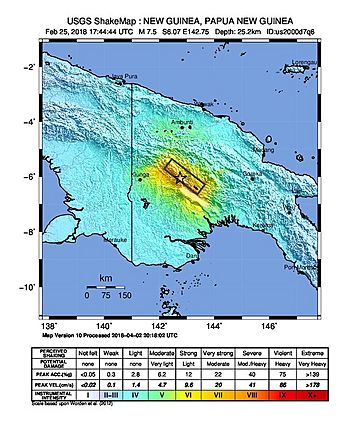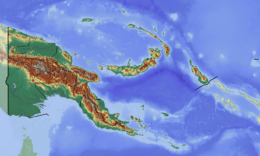2018 Papua New Guinea earthquake facts for kids

USGS shakemap for the event
|
|
| UTC time | 2018-02-25 17:44:44 |
|---|---|
| ISC event | 611709178 |
| USGS-ANSS | ComCat |
| Local date | 26 February 2018 |
| Local time | 03:44:44 |
| Magnitude | 7.5 Mw |
| Depth | 23.4 km (14.5 mi) |
| Epicenter | 6°04′05″S 142°46′05″E / 6.068°S 142.768°E |
| Type | Thrust fault |
| Areas affected | Papua New Guinea, Indonesia |
| Total damage | Building and infrastructure damage, sinkholes, landslides |
| Max. intensity | IX (Violent) |
| Landslides | Yes |
| Aftershocks | 6.7 Mw 6.2 Mw 6.0 Mw 6.0 Mw 6.0 Mw |
| Casualties | 160 dead (main shock) 11 dead (6.0 aftershock on March 4) 25 dead (6.7 aftershock on March 6) 4 dead (6.3 aftershock on April 7) |
On February 26, 2018, a very strong earthquake hit Hela Province in Papua New Guinea. It happened at 3:44 a.m. local time. The earthquake measured 7.5 on the moment magnitude scale. This scale helps scientists measure how much energy an earthquake releases.
The center of the earthquake was about 10 kilometers (6 miles) west of a town called Komo. The shaking was so strong that it was rated IX (Violent) on the Mercalli intensity scale. This scale describes how people feel an earthquake and how much damage it causes. Sadly, at least 31 people lost their lives, and over 300 were hurt.
Contents
The 2018 Papua New Guinea Earthquake
What Happened?
The main earthquake happened deep underground, about 35 kilometers (22 miles) below Mt. Sisa. Earthquakes happen when parts of the Earth's crust, called tectonic plates, suddenly move. This earthquake was caused by a thrust fault, where one part of the Earth's crust is pushed up over another.
Less than 30 minutes after the main quake, a smaller earthquake, called an aftershock, hit. This aftershock measured 5.5 on the moment magnitude scale. Aftershocks are smaller quakes that happen after a big one as the Earth's crust settles.
Damage and Aftershocks
The powerful shaking caused a lot of damage. Many buildings and important structures like roads were harmed. The ground also changed, with sinkholes appearing and large landslides happening. Landslides are when a lot of rock and soil slide down a hill.
Several strong aftershocks followed the main earthquake. Some of these aftershocks were very powerful, measuring 6.7 and 6.2 on the moment magnitude scale. These continued aftershocks caused more damage and sadly, more people were injured or died.
Help and Recovery
Because of the serious damage, a state of emergency was declared on March 1. This meant that special help and resources could be sent to the affected areas. The provinces of Hela, Southern Highlands, Enga, and Western were included in this declaration.
The government promised 450 million kina to help with the recovery. This money, which is about 136 million US$, was meant to help people rebuild their homes and lives. It also helped repair damaged infrastructure.
See also
 In Spanish: Terremoto de Papúa Nueva Guinea de 2018 para niños
In Spanish: Terremoto de Papúa Nueva Guinea de 2018 para niños


